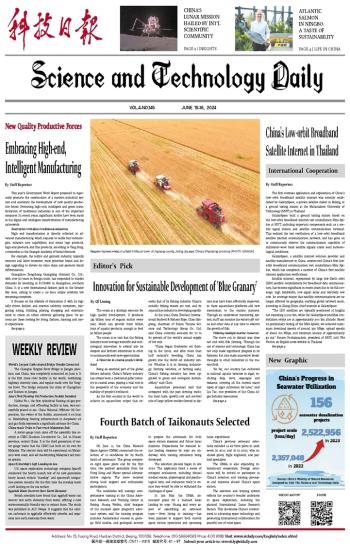
 Scooping a Treasure Chest Full of Lunar History——China's Lunar Mission Hailed by Int'l Scientific Community
Scooping a Treasure Chest Full of Lunar History——China's Lunar Mission Hailed by Int'l Scientific Community Atlantic Salmon in Ningbo: A Taste of Sustainability
Atlantic Salmon in Ningbo: A Taste of Sustainability PHOTO NEWS
PHOTO NEWS China's Low-orbit Broadband Satellite Internet in Thailand
China's Low-orbit Broadband Satellite Internet in Thailand Embracing High-end, Intelligent Manufacturing
Embracing High-end, Intelligent Manufacturing Innovation for Sustainable Development of 'Blue Granary'
Innovation for Sustainable Development of 'Blue Granary' WEEKLY REVIEW
WEEKLY REVIEW New Graphic
New Graphic Fourth Batch of Taikonauts Selected
Fourth Batch of Taikonauts Selected
The ocean is a strategic resource for high-quality development. It produces 135 billion tons of organic matter every year, which can provide three billion tons of aquatic products, enough to feed 30 billion people.
The ocean is so vast that the fishing industry must leverage scientific and technological innovation to extend into its deepest and farthest extremities in order to continuously seek new opportunities.
A vital role in coastal people's livelihood
Being an essential part of the global fishery industry, China's fishery industry has always been a traditional pillar industry in coastal areas, playing a vital role in the prosperity of the economy and the stability of people's livelihood.
As the first country in the world to achieve an aquaculture output that exceeds that of its fishing industry, China's suitable fishing waters are vast, and its aquaculture industry is developing rapidly.
At the 2024 China (Fuzhou) International Seafood & Fishery Expo, Chen Qingtang, chairman of Fujian Tianma Science and Technology Group Co., Ltd, said China currently accounts for 70 to 80 percent of the world's annual supply of live eels.
"China began freshwater eel farming in the 1970s, and after more than half century's breeding, China has grown into the world eel industry center. Whether it is in farming technology, farming varieties, or farming scale, China's fishing industry has been upgraded to green and ecological sustainability," said Chen.
Aquaculture personnel said that compared with the past farming mode, the meat taste, growth rate and survival rate of large yellow croaker farmed in distant seas have been effectively improved, so these aquaculture platforms add new momentum to the marine pastures. Through an underwater monitoring system, staff can monitor the water's pH value and other data at any time to observe the growth of fish.
Utilizing multiple marine resources
The move out to distant seas does not end with fish farming. Through the use of science and technology, China has not only made significant progress in its fisheries, but also made innovative breakthroughs in other industries in the marine field.
"So far, our country has cultivated 21 national aquatic varieties in algae, including kelp, laver, asparagus and wakame, covering all the current major types of algae cultivation we have," said Liu Tao, vice president of the China Algae Industry Association.
Also impacted by the tide of the global digital economy, the ocean is entering the era of digitalization and intelligence. With the rapid advancement of intelligent ocean construction, 5G, BeiDou Navigation Satellite System, Internet of Things, AI, big data and other new information technologies are widely used in marine fisheries, maritime safety operations, offshore aquaculture, the petrochemical industry, ports and other fields.
In the marine ranch complex in Yantai, Shandong province, the combination of aquaculture and marine tourism has created a new development model of "blue granary plus blue cultural tourism," and for the first time in China, aquaculture, intelligent fisheries, leisure fisheries, and sci-tech R&D are integrated on the same platform.

 Next
Next



